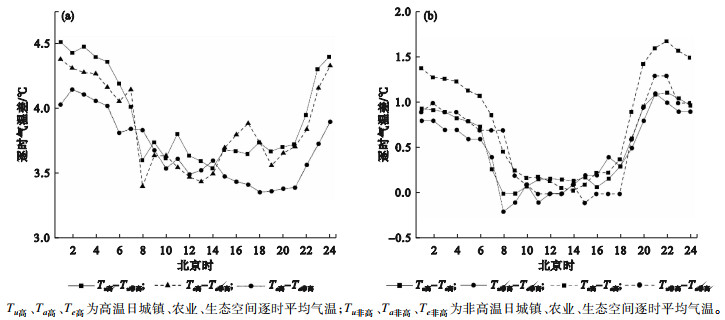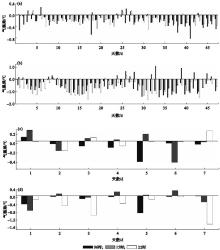国际刊号:ISSN 1673-503X
国内刊号:CN 21-1531/P

Journal of Meteorology and Environment ›› 2024, Vol. 40 ›› Issue (2): 51-58.doi: 10.3969/j.issn.1673-503X.2024.02.007
• Articles • Previous Articles Next Articles
Huosheng LIU1( ),Jiahui ZAN2,Yatian CHENG2,Qianhui YU1,Changguang WU2,*(
),Jiahui ZAN2,Yatian CHENG2,Qianhui YU1,Changguang WU2,*( )
)
Received:2023-04-17
Online:2024-04-28
Published:2024-05-25
Contact:
Changguang WU
E-mail:liu376752469@163.com;wcg@mail.hzau.edu.cn
CLC Number:
Huosheng LIU,Jiahui ZAN,Yatian CHENG,Qianhui YU,Changguang WU. Analysis of spatiotemporal variations in air temperature among three types of spaces in Wuhan city during the summer of 2022[J]. Journal of Meteorology and Environment, 2024, 40(2): 51-58.

Fig.4
Hourly air temperature differences in urban, agricultural, and ecological spaces in the urban development area of Wuhan city on high-temperature days and non-high-temperature days (a), and hourly air temperature differences between urban spaces and agricultural/ecological spaces on high-temperature days and non-high-temperature days (b) from June to August of 2022"


Fig.6
Daily air temperature differences in the urban spaces near and far from ecological spaces during high-temperature days (a) and non-high-temperature days (c) at 06:00, 15:00, and 22:00, and daily air temperature differences in the urban spaces near and far from agricultural spaces during high-temperature days (b) and non-high-temperature days (d) at 06:00, 15:00, and 22:00 in the urban development area of Wuhan city from June to August of 2022"

| 1 | IPCC . Climate Change 2021:The physical science basis.Contribution working group Ⅰ to the sixth assessment report of the Intergovernmental Panel on Climate Change[M]. Cambridge, United Kingdom and New York, NY, USA: Cambridge University Press, 2021. |
| 2 |
郑小华, 娄盼星, 马永永. 1961—2018年陕西极端气温时空变化特征[J]. 气象与环境学报, 2021, 37 (3): 81- 87.
doi: 10.3969/j.issn.1673-503X.2021.03.011 |
| 3 | 姜荣, 魏宁, 陈亮, 等. 上海市高温日的日最高气温空间分布特征及改善措施[J]. 气象与环境学报, 2016, 32 (5): 84- 91. |
| 4 |
Yang X S , Yao L Y , Jin T , et al. Assessing the thermal behavior of different local climate zones in the Nanjing metropolis, China[J]. Building and Environment, 2018, 137, 171- 184.
doi: 10.1016/j.buildenv.2018.04.009 |
| 5 | 赵迦琪. 呼包鄂地区气候舒适度时空变化及其关键气象因子分析[J]. 气象与环境学报, 2022, 38 (2): 78- 88. |
| 6 |
Cao X , Onishi A , Chen J , et al. Quantifying the cool island intensity of urban parks using ASTER and IKONOS data[J]. Landscape and Urban Planning, 2010, 96 (4): 224- 231.
doi: 10.1016/j.landurbplan.2010.03.008 |
| 7 | 成雅田, 吴昌广. 基于局地气候优化的城市蓝绿空间规划途径研究进展[J]. 应用生态学报, 2020, 31 (11): 3935- 3945. |
| 8 |
Du H Y , Song X J , Jiang H , et al. Research on the cooling island effects of water body: A case study of Shanghai, China[J]. Ecological Indicators, 2016, 67, 31- 38.
doi: 10.1016/j.ecolind.2016.02.040 |
| 9 | 吴昌广, 夏丽丽, 林姚宇, 等. 深圳市典型住区热环境特征及其影响因子分析[J]. 哈尔滨工业大学学报, 2015, 47 (6): 59- 62. |
| 10 |
Sheng Y L , Liu X P , Yang X C , et al. Quantifying the spatial and temporal relationship between air and land surface temperatures of different land-cover types in Southeastern China[J]. International Journal of Remote Sensing, 2017, 38 (4): 1114- 1136.
doi: 10.1080/01431161.2017.1280629 |
| 11 |
Mathew A , Khandelwal S , Kaul N , et al. Analyzing the diurnal variations of land surface temperatures for surface urban heat island studies: Is time of observation of remote sensing data important?[J]. Sustainable Cities and Society, 2018, 40, 194- 213.
doi: 10.1016/j.scs.2018.03.032 |
| 12 | 朱玲, 龚强, 王小桃, 等. 辽宁省地气温差变化特征及其原因分析[J]. 气象与环境学报, 2017, 33 (4): 71- 77. |
| 13 | 梁颢严. 城市控制性详细规划热环境影响因子及评价模型研究[D]. 广州: 华南理工大学, 2018: 106-159. |
| 14 |
Cao J , Zhou W Q , Zheng Z , et al. Within-city spatial and temporal heterogeneity of air temperature and its relationship with land surface temperature[J]. Landscape and Urban Planning, 2021, 206, 103979.
doi: 10.1016/j.landurbplan.2020.103979 |
| 15 | 张本志, 任国玉, 张子曰, 等. 北京中心商务区夏季近地面气温时空分布特征[J]. 气象与环境学报, 2013, 29 (5): 26- 34. |
| 16 | 王颖, 刘学良, 魏旭红, 等. 区域空间规划的方法和实践初探——从"三生空间"到"三区三线"[J]. 城市规划学刊, 2018, (4): 65- 74. |
| 17 | 刘志超. 新型空间规划体系下的县级"三生空间"布局与"三线"划定[J]. 规划师, 2019, 35 (5): 27- 31. |
| 18 |
Wang Y S , Ouyang W L . Investigating the heterogeneity of water cooling effect for cooler cities[J]. Sustainable Cities and Society, 2021, 75, 103281.
doi: 10.1016/j.scs.2021.103281 |
| 19 |
Yao L Y , Sailor D J , Zhang X , et al. Diurnal pattern and driving mechanisms of the thermal effects of an urban pond[J]. Sustainable Cities and Society, 2023, 91, 104407.
doi: 10.1016/j.scs.2023.104407 |
| 20 | 王晓默, 张翠翠, 董宁, 等. 不同气象条件下济宁城市热岛效应的变化特征[J]. 南京信息工程大学学报(自然科学版), 2016, 8 (2): 160- 165. |
| 21 | 黄群芳, 颜敏. 典型气象条件下城市热岛效应逐时变化特征[J]. 气象科学, 2022, 42 (3): 402- 409. |
| 22 |
Chew L W , Liu X , Li X X , et al. Interaction between heat wave and urban heat island: A case study in a tropical coastal city, Singapore[J]. Atmospheric Research, 2021, 247, 105134.
doi: 10.1016/j.atmosres.2020.105134 |
| 23 |
Richard Y , Pohl B , Rega M , et al. Is Urban Heat Island intensity higher during hot spells and heat waves(Dijon, France, 2014-2019)?[J]. Urban Climate, 2021, 35, 100747.
doi: 10.1016/j.uclim.2020.100747 |
| 24 |
Wang Q , Zhang C , Ren C , et al. Urban heat island circulations over the Beijing-Tianjin region under calm and fair conditions[J]. Building and Environment, 2020, 180, 107063.
doi: 10.1016/j.buildenv.2020.107063 |
| 25 | Kabisch N , Kraemer R . Physical activity patterns in two differently characterized urban parks under conditions of summer heat[J]. Environmental Science & Policy, 2020, 107, 56- 65. |
| 26 | Wang Y C , Sheng S , Xiao H B . The cooling effect of hybrid land-use patterns and their marginal effects at the neighborhood scale[J]. Urban Forestry & Urban Greening, 2021, 59, 127015. |
| 27 | 陈光, 李楠, 蔡云楠, 等. 基于LCZ的广州夏季热岛强度特征分析[J]. 建筑科学, 2021, 37 (6): 96- 104. |
| 28 |
Zhao Z Q , Sharifi A , Dong X , et al. Spatial variability and temporal heterogeneity of surface urban heat island patterns and the suitability of local climate zones for land surface temperature characterization[J]. Remote Sensing, 2021, 13 (21): 4338.
doi: 10.3390/rs13214338 |
| 29 |
Zhu D , Zhou X F , Cheng W . Water effects on urban heat islands in summer using WRF-UCM with gridded urban canopy parameters-A case study of Wuhan[J]. Building and Environment, 2022, 225, 109528.
doi: 10.1016/j.buildenv.2022.109528 |
| 30 |
Jiang P , Liu Q Y , Xu Z H , et al. How to effectively mitigate urban heat island effect? A perspective of waterbody patch size threshold[J]. Landscape and Urban Planning, 2020, 202, 103873.
doi: 10.1016/j.landurbplan.2020.103873 |
| 31 |
Xu H H , Chen H , Zhou X F , et al. Research on the relationship between urban morphology and air temperature based on mobile measurement: A case study in Wuhan, China[J]. Urban Climate, 2020, 34, 100671.
doi: 10.1016/j.uclim.2020.100671 |
| [1] | ZHU Ling, GONG Qiang, WANG Xiao-tao, LI Qian, XU Hong, CHAO Hua, GU Zheng-qiang, SHEN Li-du, LIN Na. Change characteristics of ground-air temperature difference and their causes in Liaoning province [J]. Journal of Meteorology and Environment, 2017, 33(4): 71-77. |
| Viewed | ||||||
|
Full text |
|
|||||
|
Abstract |
|
|||||
|